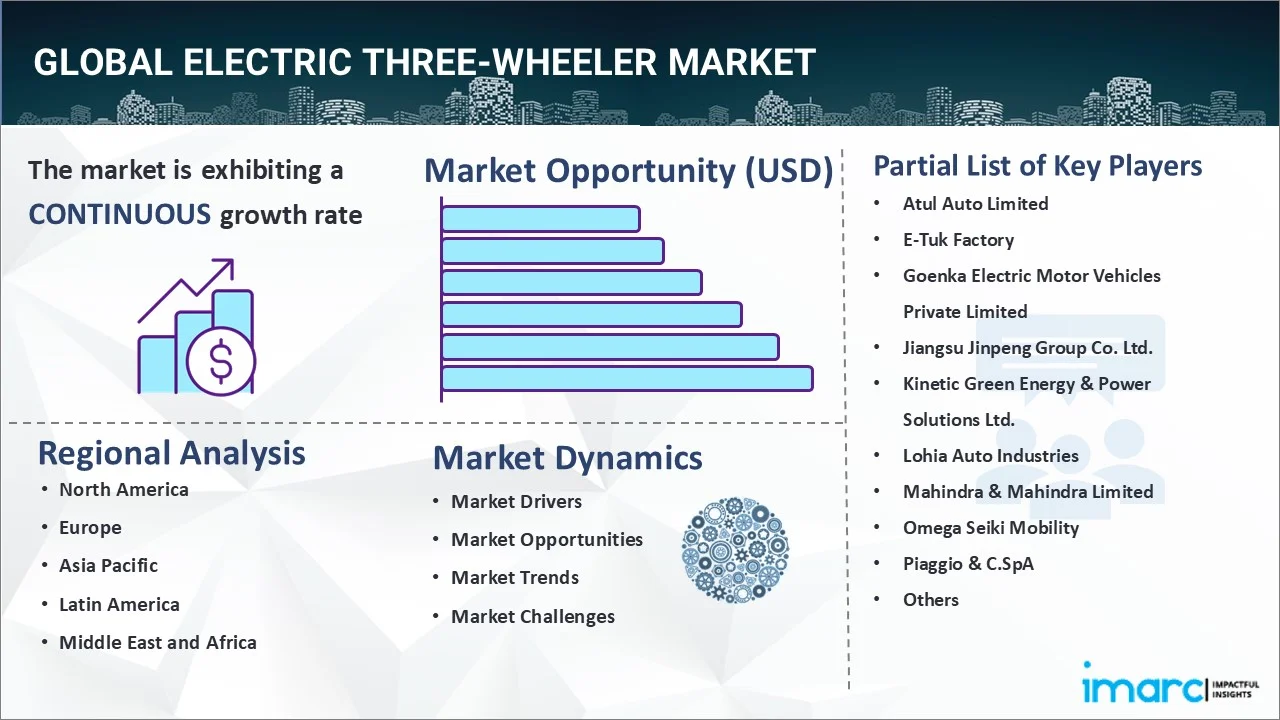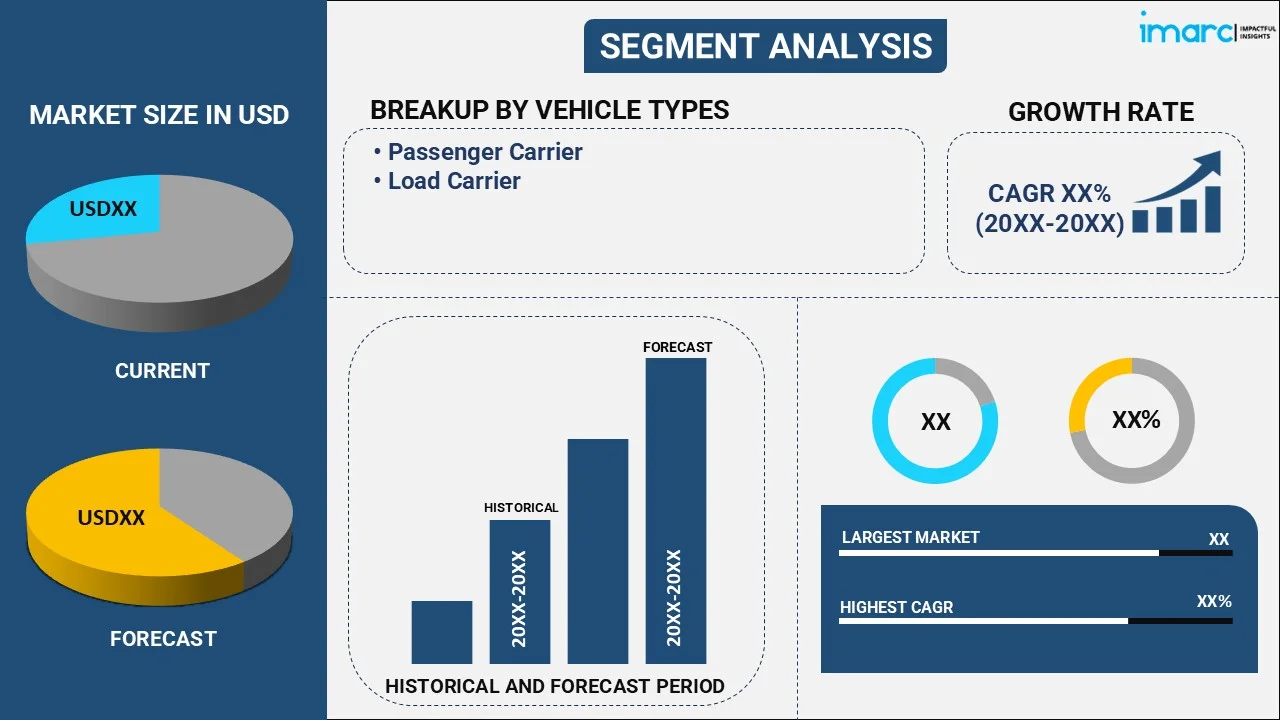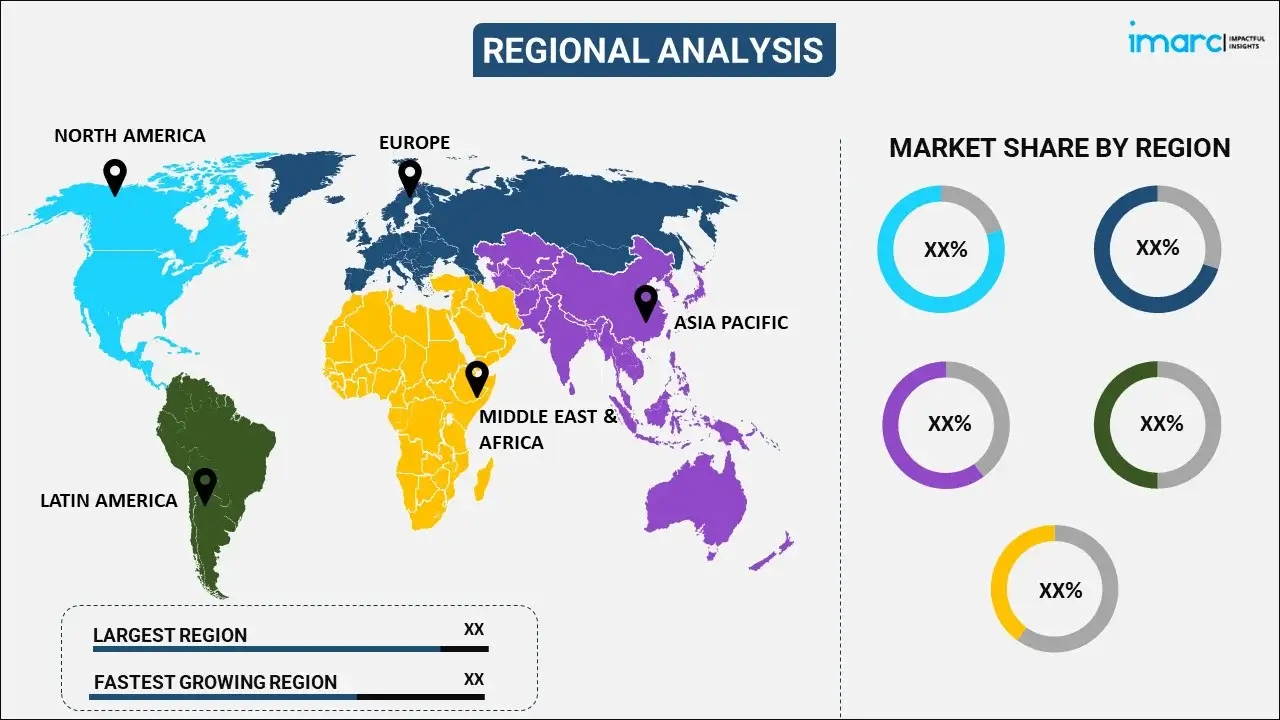
Electric Three-Wheeler Market Report by Vehicle Type (Passenger Carrier, Load Carrier), Power Type (Up To 1000W, 1000W To 1500W, Above 1500W), Battery Type (Lithium-Ion, Lead Acid), and Region 2025-2033
Electric Three-Wheeler Market Overview:
The global electric three-wheeler market size reached USD 783 Million in 2024. Looking forward, IMARC Group expects the market to reach USD 1,565.2 Million by 2033, exhibiting a growth rate (CAGR) of 8% during 2025-2033. The growing demand for eco-friendly transportation, favorable government policies and incentives, advancements in battery technology, rising fuel prices, and expanding applications in passenger and goods transportation are some of the factors impelling the market growth.
|
Report Attribute
|
Key Statistics
|
|---|---|
|
Base Year
|
2024 |
|
Forecast Years
|
2025-2033
|
|
Historical Years
|
2019-2024
|
| Market Size in 2024 | USD 783 Million |
| Market Forecast in 2033 | USD 1,565.2 Million |
| Market Growth Rate (2025-2033) | 8% |
Electric Three-Wheeler Market Analysis:
- Major Market Drivers: The market is experiencing strong growth due to rising urban population, strict emission standards, government incentives, and financial support for electric vehicle (EV) adoption. Furthermore, improvements in battery technology and the reduced overall cost of ownership in comparison to traditional vehicles are contributing to the growth of the market.
- Key Market Trends: Advancements in battery technologies, incorporation of smart features and the internet of things (IoT) in vehicles, and the rise in shared mobility options are strengthening the market growth. There is also a shift towards using lithium-ion (Li-ion) batteries instead of traditional lead-acid batteries.
- Geographical Trends: Asia Pacific dominates the market, primarily because of increasing environmental concerns and supportive government regulations.
- Competitive Landscape: Some of the major market players in the industry include Atul Auto Limited, E-Tuk Factory, Goenka Electric Motor Vehicles Private Limited, Jiangsu Jinpeng Group Co. Ltd., Kinetic Green Energy & Power Solutions Ltd., Lohia Auto Industries, Mahindra & Mahindra Limited, Omega Seiki Mobility, Piaggio & C.SpA, Scooters India Limited, Terra Motors Corporation, among many others.
- Challenges and Opportunities: The high initial cost of electric three-wheelers, limited charging infrastructure, and battery disposal issues, are some of the challenges influencing the electric three-wheeler market revenue. Nonetheless, there are opportunities in the progress of technology, expansion of charging networks, and the increasing popularity of EVs in developed and developing areas.

Electric Three-Wheeler Market Trends:
Rising Urbanization and Need for Cost-Effective Transportation
With the rise in urban populations, the need for affordable, efficient, and eco-friendly transportation choices is increasing, particularly in densely populated areas. Electric three-wheelers are a perfect solution for short-distance travel and last-mile connectivity in regions where traffic congestion and pollution are major concerns. These vehicles have reduced operational and maintenance expenses when compared with conventional internal combustion engine vehicles, attracting both individual commuters and commercial fleet operators. The economic advantages, along with the necessity for environment-friendly transportation, are contributing to the electric three-wheeler market growth. Their compact size, zero emissions, and cost-efficiency address the unique challenges of urban mobility, making them increasingly popular. In June 2024, Omega Seiki Mobility released two models of the electric three-wheeler, OSM Stream City ATR with a swappable battery and Stream City 8.5 with a fixed battery, designed for urban mobility.
Collaborative Initiatives and Strategic Partnership
Cooperative efforts and strategic alliances among manufacturers, battery suppliers, technology companies, and government entities are speeding up improvements and distribution of electric three-wheelers. Partnerships and agreements for joint development enable stakeholders to combine resources and knowledge, improving vehicle performance and cutting down on expenses. Collaborative research operations aim to improve battery technology and incorporate essential smart features for market expansion. Partnership between vehicle manufacturers and charging station providers improve the incorporation and accessibility of charging options, which helps overcome a major obstacle to widespread use. These collaborations simplify the production process and establish a favorable environment for electric three-wheelers. Collaboration among all involved parties can help tackle technical and economic obstacles, leading to a more stable and eco-friendly electric three-wheeler industry. In line with the electric three-wheeler market recent developments, in August 2023, Omega Seiki Mobility collaborated with Punjab National Bank (PNB) to improve the availability of retail EVs and simplify financing for electric three-wheelers. The partnership sought to fund another 7,500 electric vehicles (EVs) totaling INR 300 crore in the following three years.
Government Incentives and Environmental Policies
Authorities in numerous countries are implementing strategies to reduce carbon emissions and promote the adoption of sustainable transportation. Government financial support in the form of subsidies, tax breaks, and grants is decreasing the cost and improving the appeal of electric three-wheelers for both manufacturers and buyers. Rules regarding emission standards are also driving traditional combustion engine three-wheeler manufacturers to transition to electric models. They are also making substantial investments in charging infrastructure and providing incentives to fleet operators to encourage the adoption of EVs. These initiatives not only reduce the upfront costs of electric three-wheelers but also enhance user confidence and market adoption. The Government of India launched the Electric Mobility Promotion Scheme 2024 on March 13, 2024, with a budget of INR 500 crore to support 372,215 electric two-wheelers and three-wheelers through subsidies from April 1, 2024, to July 31, 2024. The scheme aimed to speed up the adoption of EVs in these categories.
Electric Three-Wheeler Market Segmentation:
IMARC Group provides an analysis of the key electric three-wheeler market trends in each segment, along with forecasts at the global, regional, and country levels for 2025-2033. Our report has categorized the market based on vehicle type, power type, and battery type.
Breakup by Vehicle Type:

- Passenger Carrier
- Load Carrier
Passenger carrier accounts for the majority of the market share
The report has provided a detailed breakup and analysis of the market based on the vehicle type. This includes passenger carrier and load carrier. According to the report, passenger carrier represented the largest segment.
Passenger carrier holds the largest market share because of the increasing demand for affordable, effective, and eco-friendly transportation options in cities. These vehicles are widely used for short-distance travel and last-mile connectivity, providing a convenient alternative to traditional auto-rickshaws and public transportation systems. The increasing urbanization, along with government incentives and favorable policies are encouraging the adoption of EVs. The IMARC Group projects that by 2032, the market will reach 381.3 million units.
Breakup by Power Type:
- Up To 1000W
- 1000W To 1500W
- Above 1500W
1000W to 1500W leads the market, accounting for the largest electric three-wheeler market share
A detailed breakup and analysis of the market based on the power type have also been provided in the report. This includes up to 1000W, 1000W to 1500W, and above 1500W. According to the report, 1000W to 1500W accounted for the largest market share.
1000W to 1500W accounts for the majority of the market share because of its ideal combination of power, efficiency, and cost efficiency. Vehicles in this power range are ideal for city and semi-urban areas, offering enough power to navigate through urban traffic while also being energy efficient. They provide reliable performance for transporting passengers and cargo, making them very versatile and popular with both individuals and commercial operators. The developments in motor and battery technology are improving the performance of electric three-wheelers in this category, resulting in increased range and quicker charging speeds. 1000W to 1500W segment leads the market, addressing the diverse transportation needs of a broad user base.
Breakup by Battery Type:
- Lithium-Ion
- Lead Acid
Lithium-ion exhibits a clear dominance in the market
A detailed breakup and analysis of the market based on the battery type have also been provided in the report. This includes lithium-ion and lead acid. According to the report, lithium-ion accounted for the largest market share.
Lithium-ion (Li-ion) is the predominant segment as per the electric three-wheeler market outlook. As per the IMARC Group, in 2023, the size of the worldwide Li-ion battery market hit US$ 51.0 Billion. Li-ion batteries are favored for their higher energy density, extended lifespan, and fast charging abilities. These batteries provide improved performance and efficiency, resulting in increased travel range per charge and lower maintenance expenses. Furthermore, the reduced expenses of Li-ion batteries, influenced by technological progress and economies of scale, are allowing electric three-wheeler producers to use them more easily and cost-effectively.
Breakup by Region:

- North America
- United States
- Canada
- Asia-Pacific
- China
- Japan
- India
- South Korea
- Australia
- Indonesia
- Others
- Europe
- Germany
- France
- United Kingdom
- Italy
- Spain
- Russia
- Others
- Latin America
- Brazil
- Mexico
- Others
- Middle East and Africa
Asia Pacific holds the largest share of the industry
The report has also provided a comprehensive analysis of all the major regional markets, which include North America (the United States and Canada); Asia Pacific (China, Japan, India, South Korea, Australia, Indonesia, and others); Europe (Germany, France, the United Kingdom, Italy, Spain, Russia, and others); Latin America (Brazil, Mexico, and others); and the Middle East and Africa. According to the report, Asia Pacific represents the largest regional market for electric three-wheeler.
Asia Pacific dominates the market, mainly due to rapid urbanization, increasing environmental concerns among the public, and favorable government regulations. The rate of urbanization for people living in one place all year increased by more than three times since 1982, reaching 66.2% in 2023, as per the China in Numbers (2023) report by the United Nations Development Programme (UNDP). The large population in the area and increasing desire for cost-effective, effective urban transportation options are driving the electric three-wheeler demand. Government aid and financial support for the adoption of EVs, along with increasing fuel prices, result in electric three-wheelers being a financially efficient option compared to conventional vehicles. Furthermore, with a strong manufacturing foundation and advancements in battery technology, the Asia Pacific region is positioned as the leading player in the global market.
Competitive Landscape:
- The market research report has also provided a comprehensive analysis of the competitive landscape in the market. Detailed profiles of all major companies have also been provided. Some of the major market players in the industry include Atul Auto Limited, E-Tuk Factory, Goenka Electric Motor Vehicles Private Limited, Jiangsu Jinpeng Group Co. Ltd., Kinetic Green Energy & Power Solutions Ltd., Lohia Auto Industries, Mahindra & Mahindra Limited, Omega Seiki Mobility, Piaggio & C.SpA, Scooters India Limited, and Terra Motors Corporation.
(Please note that this is only a partial list of the key players, and the complete list is provided in the report.)
- Electric three-wheeler companies are prioritizing strategic actions like broadening their product offerings, upgrading battery technology, and enhancing vehicle performance in order to solidify their market standings. They are investing in research operations to incorporate advanced features such as smart connectivity and enhanced safety measures in their products. Moreover, these businesses are establishing strategic alliances and partnerships to strengthen their distribution channels and expand into new geographic areas. In 2023, Voi Mobility collaborated with BILITI Electric to test an electric tuk-tuk for managing e-scooters in the UK, enabling transportation solutions for the final mile. BILITI's Taskman e-3W was put into action in Bristol for duties such as changing batteries and upkeep, helping to support an eco-friendly transportation service.
Electric Three-Wheeler Market News:
- March 2024: Atul Auto Limited completed a strategic investment of INR 19.99 crore in its subsidiary, Atul Greentech Private Limited (AGPL), securing an 80% stake. This move aimed to strengthen Atul Auto's presence in the EV sector by bolstering AGPL's capabilities in producing electric three-wheelers and providing EV parts and spares.
- August 2023: Mahindra Last Mile Mobility launched the Mahindra e-Alfa Super with a 20% increased range, enhanced safety features, and comprehensive warranties. This new e-rickshaw will be the most viable self-employment option for driver partners with its higher range, best-in-class safety and comfort features.
- February 2023: Piaggio Vehicles launched the electric three-wheeler Ape Electrik in the Philippines for last-mile mobility. The vehicle will be manufactured at PVPL's Baramati manufacturing facility in Maharashtra.
Electric Three-Wheeler Market Report Scope:
| Report Features | Details |
|---|---|
| Base Year of the Analysis | 2024 |
| Historical Period | 2019-2024 |
| Forecast Period | 2025-2033 |
| Units | Million USD |
| Scope of the Report | Exploration of Historical Trends and Market Outlook, Industry Catalysts and Challenges, Segment-Wise Historical and Future Market Assessment:
|
| Vehicle Types Covered | Passenger Carrier, Load Carrier |
| Power Types Covered | Up To 1000W, 1000W To 1500W, Above 1500W |
| Battery Types Covered | Lithium-Ion, Lead Acid |
| Regions Covered | Asia Pacific, Europe, North America, Latin America, Middle East and Africa |
| Countries Covered | United States, Canada, Germany, France, United Kingdom, Italy, Spain, Russia, China, Japan, India, South Korea, Australia, Indonesia, Brazil, Mexico |
| Companies Covered | Atul Auto Limited, E-Tuk Factory, Goenka Electric Motor Vehicles Private Limited, Jiangsu Jinpeng Group Co. Ltd., Kinetic Green Energy & Power Solutions Ltd., Lohia Auto Industries, Mahindra & Mahindra Limited, Omega Seiki Mobility, Piaggio & C.SpA, Scooters India Limited, Terra Motors Corporation, etc. |
| Customization Scope | 10% Free Customization |
| Post-Sale Analyst Support | 10-12 Weeks |
| Delivery Format | PDF and Excel through Email (We can also provide the editable version of the report in PPT/Word format on special request) |
Key Benefits for Stakeholders:
- IMARC’s industry report offers a comprehensive quantitative analysis of various market segments, historical and current market trends, electric three-wheeler market forecasts, and dynamics of the market from 2019-2033.
- The research report provides the latest information on the market drivers, challenges, and opportunities in the global market.
- The study maps the leading, as well as the fastest-growing, regional markets. It further enables stakeholders to identify the key country-level markets within each region.
- Porter's five forces analysis assists stakeholders in assessing the impact of new entrants, competitive rivalry, supplier power, buyer power, and the threat of substitution. It helps stakeholders to analyze the level of competition within the market and its attractiveness.
- The competitive landscape allows stakeholders to understand their competitive environment and provides insight into the current positions of key players in the electric three-wheeler industry.
Key Questions Answered in This Report
The global electric three-wheeler market was valued at USD 783 Million in 2024.
We expect the global electric three-wheeler market to exhibit a CAGR of 8% during 2025-2033.
The increasing use of electric three-wheeler as a convenient and eco-friendly mode of public transportation, is primarily driving the global electric three-wheeler market.
The sudden outbreak of the COVID-19 pandemic had led to the growing consumer inclination towards personal vehicles, to combat the risk of the coronavirus infection, thereby limiting the demand for public transports, such as electric three-wheelers.
Based on the vehicle type, the global electric three-wheeler market can be segmented into passenger carrier and load carrier. Currently, passenger carrier holds the majority of the total market share.
Based on the power type, the global electric three-wheeler market has been divided into up to 1000W, 1000W to 1500W, and above 1500W. Among these, 1000W to 1500W exhibits a clear dominance in the market.
Based on the battery type, the global electric three-wheeler market can be categorized into lithium-ion and lead acid. Currently, lithium-ion based battery accounts for the largest market share.
On a regional level, the market has been classified into North America, Asia-Pacific, Europe, Latin America, and Middle East and Africa, where Asia-Pacific currently dominates the global market.
Some of the major players in the global electric three-wheeler market include Atul Auto Limited, E-Tuk Factory, Goenka Electric Motor Vehicles Private Limited, Jiangsu Jinpeng Group Co. Ltd., Kinetic Green Energy & Power Solutions Ltd., Lohia Auto Industries, Mahindra & Mahindra Limited, Omega Seiki Mobility, Piaggio & C.SpA, Scooters India Limited and Terra Motors Corporation.
Need more help?
- Speak to our experienced analysts for insights on the current market scenarios.
- Include additional segments and countries to customize the report as per your requirement.
- Gain an unparalleled competitive advantage in your domain by understanding how to utilize the report and positively impacting your operations and revenue.
- For further assistance, please connect with our analysts.
 Request Customization
Request Customization
 Speak to an Analyst
Speak to an Analyst
 Request Brochure
Request Brochure
 Inquire Before Buying
Inquire Before Buying




.webp)




.webp)












